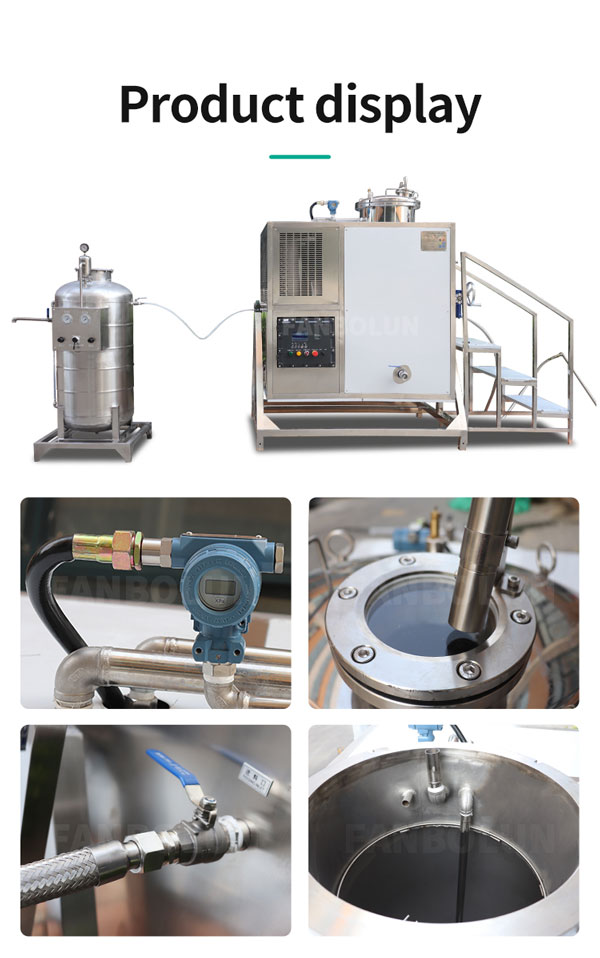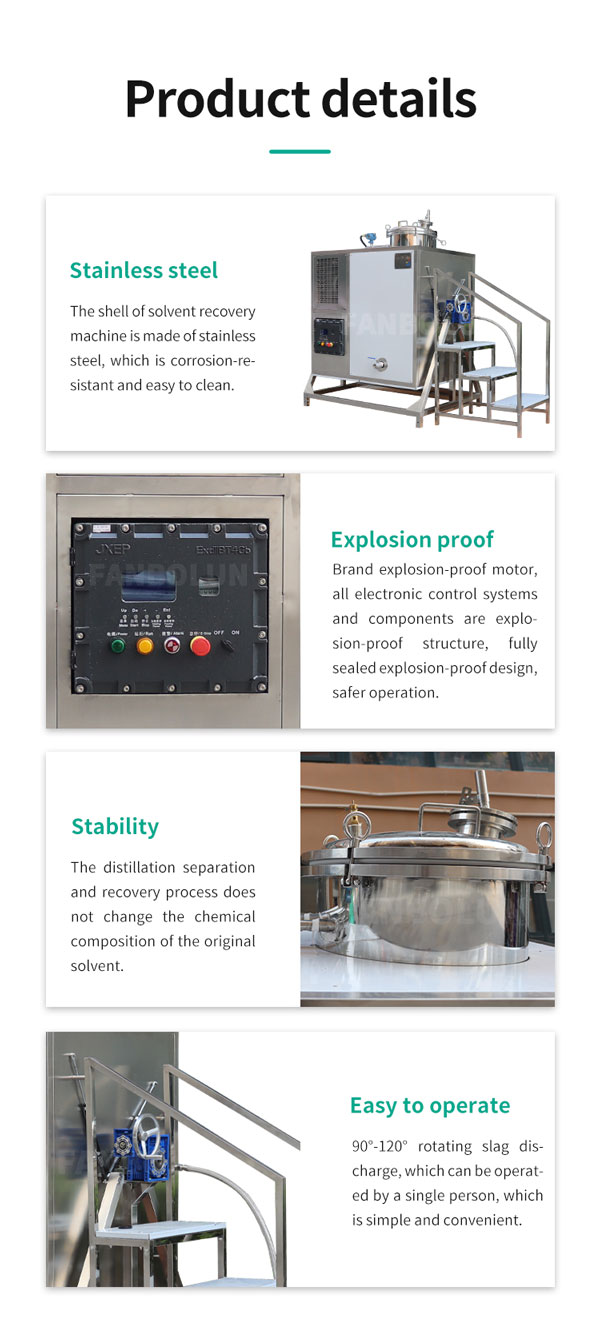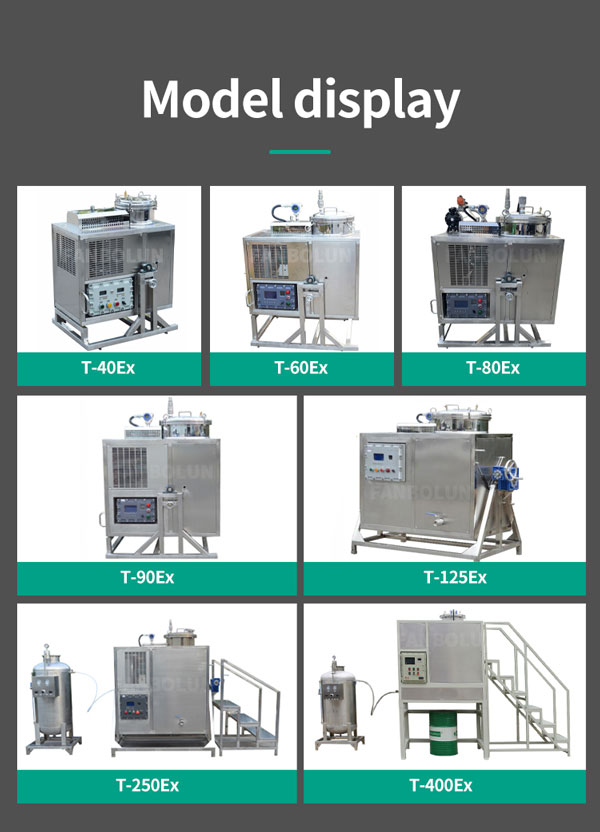Introduction To Solvent Recycling System
T-80Ex solvent recycling system with a feed capacity of 80l is a device or process for recovering and recycling solvents used in paint operations. Solvent recycling systems generally work by collecting used solvent and separating it from paint residue. The collected solvent is then distilled or purified to remove any impurities and can then be reused in the painting process.
Structure Of Solvent Recycling System
Solvent Collection Vessel:
The container or drum in which used solvent is collected from a process or equipment.
Solvent Transfer Pump:
The pump that transfers the used solvent from the collection vessel to the distillation unit.
Distillation Unit:
The distillation unit or still is the heart of the solvent recovery system. It heats the used solvent to its boiling point, evaporates it, then condenses and collects the resulting vapor as a purification solvent.
Condenser:
A device that cools and condenses solvent evaporated in a distillation unit into a liquid state.
Solvent Storage Containers:
Containers or drums in which purified solvents are stored for reuse.
Filters and Separators:
These components help to remove any impurities, particles or debris from the solvent before it enters the distillation unit. It can be a simple filter or a separator that separates heavier impurities by gravity.
Control and Monitoring Systems:
Computerized or manual control and monitoring systems to manage the operation of the solvent recovery system, controlling temperature, pressure and flow rates, and providing safety alarms and shutdowns when required.

Solvent Recycling System Application Industry:
-
Automobile manufacturing and repair industry:
Cleaning thinner for vehicle spraying equipment pipelines and spray guns, such as thinner, toluene, xylene, methyl ethyl ketone, butyl ester, etc.; solvents produced in the process of cleaning engine gasoline, etc.
-
Electronic product manufacturing industry (such as: LCD, LED, etc.):
Cleaning agents for cleaning molds and cleaning electronic products, such as: absolute ethanol, acetone, trichlorethylene, etc.
-
Precision instrument and hardware manufacturing industry:
Organic solvents for cleaning molds and processed products, such as thinner, hydrocarbons, kerosene, solvent gasoline, etc.
-
Sports equipment manufacturing industry:
Cleaning agents for wax-melted castings such as golf heads and fishing rods, and solvents for spraying and cleaning clubs and fishing rods.
-
Shoe material industry:
Various organic solvents for cleaning spraying equipment, such as: shoe outsole, heel spraying, shoe upper printing processing cleaning, etc.
-
Plastic products:
Organic solvents for cleaning molds and processed products, such as solvents for printing cleaning.
-
Printing industry:
Cleaning agent for cleaning printing plates and machines, such as board washing water, car washing water, etc.

Operation Of Solvent Recycling System
- Before using the solvent recycling system for the first time, pay attention to check whether the power supply is connected correctly, and make sure that the bolts of the control box are tightened; turn on the power switch to check that the cooling fan is operating normally.
- The level of the waste liquid put in should be lower than the maximum liquid level line, and the contact surface between the gasket and the flange should be cleaned carefully to prevent the solvent vapor from leaking out.
- Turn on the switch of the solvent recovery machine, press the start button and the device will start to run, make sure there is enough big barrels to hold clean liquid to avoid overflow
- It is strictly forbidden to pour the waste solvent containing peroxide and a large amount of digestive cotton into the barrel for recycling to avoid gas explosion.
- It is strictly forbidden to store a large amount of waste solvent equipment near the recycling machine and the tank must be connected with electrostatic clamps.
- It is strictly forbidden to smoke near the recycling machine, and the power switch is explosion-proof.
- During the operation, it is strictly forbidden to open the cover directly without cooling, and touch the hot part of the tank to avoid danger.
- If any failure is found, please turn off the power and notify the maintenance personnel to deal with it. You must wait for the solvent recycling system to cool down before handling it.
- When recycling some unknown liquids, please consult the corresponding professionals to avoid potential safety hazards.
- After the recovery is completed, clean up the recovered solvent and residue, and turn off the power.

Parameter
| Model | T-40 | T-60 | T-80 | T-90 | T-125 |
| Feed Capacity (L) | 40 | 60 | 80 | 90 | 125 |
| Heating Component Power (KW) | 4.0 | 4.0 | 5.0 | 5.0 | 6.0 |
| Electric Fan Power (KW) | 0.09 | 0.12 | 0.12 | 0.12 | 0.12 |
| Maximum Power (KW) | 4.5 | 4.5 | 5.5 | 5.5 | 6.5 |
| Maximum Current (A) | 6.9 | 6.9 | 8.4 | 8.4 | 10 |
| supply Voltage (ACV/HZ) | 3-phase 5-line 380/50-60 | ||||
| Control Voltage (ACVHZ) | 220/50-60 | ||||
| Heating Method | Hot medium oil indirect heating | ||||
| Length (mm) | 950 | 1100 | 1100 | 1100 | 1150 |
| Width (mm) | 750 | 750 | 850 | 850 | 850 |
| Height (mm) | 1200 | 1200 | 1260 | 1260 | 1435 |
| Weight (kg) | 140 | 160 | 250 | 260 | 300 |
| operate Temperature (℃) | 50~210 | ||||
| The Best Ambient Temperature For The Machine To Run (℃) | 5~35 | ||||
| Noise (dB) | 65 | ||||
| Recovery Ratio | 95% | ||||
| Recovery Time | 2.5~3.0 | 2.5~3.0 | 2.5~3.0 | 2.5~3.0 | 3.0~3.5 |
FAQ
Q: How long is the service life of solvent recycling system?
A: The service life of the solvent recycling system may vary depending on the specific system and its maintenance. With proper maintenance and care, a solvent recovery system can last for many years.
Q: Can the solvent recycling system be customized for specific applications?
A: Yes, the solvent recycling system can be customized to meet the specific needs of different applications. This may involve modifying system components or adding functionality to meet unique requirements.
Q: Is a solvent recycling system cost effective for small scale painting jobs?
A: The cost-effectiveness of a solvent recycling system for small-scale paint operations depends on a variety of factors, such as the volume of solvent used, the frequency of solvent recycling, and the cost of new solvent purchases. A cost-benefit analysis helps determine whether a solvent recycling system is a viable option for a particular operation.




